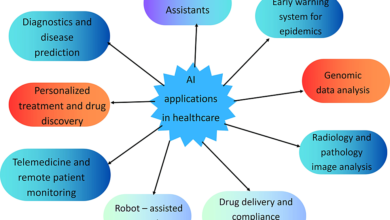Nvidia Stock Is Down 11% From Record Highs: Will This Artificial Intelligence (AI) Development Bring More Bad News for Investors?

Should Nvidia investors be worried about more downside following an announcement from a rival?
Nvidia (NVDA -2.68%) hit record highs last month, with shares of the chipmaker jumping to $974 on March 8. But investors haven’t had much reason to cheer since then, as this red-hot stock has been cooling down ever since.
More specifically, Nvidia stock now trades just over 11% below that record high. Wall Street is worried that the stock’s bubble may have popped, and its artificial intelligence (AI)-powered growth could fizzle out thanks to intensifying competition in the market for AI chips. So it wasn’t surprising to see Nvidia stock retreat another 2% on April 9 following Intel‘s (INTC -5.16%) launch of a new AI chip, which took direct aim at Nvidia’s hottest performers.
Let’s see if Nvidia investors have reason to worry following Intel’s latest move to target the fast-growing AI chip market.
Intel takes aim at Nvidia’s AI supremacy
Intel has been trying hard to sink its teeth into the AI chip market, but the company’s efforts have not gone far. At the end of 2023, Intel’s potential revenue pipeline from AI chips was “well above $2 billion and growing,” according to CEO Pat Gelsinger. That pales in comparison to Nvidia’s fiscal 2024 data center revenue of $47.5 billion, indicating that it is miles ahead of Intel in the AI chip market at present.
However, Chipzilla is taking another shot at Nvidia’s AI dominance with its latest Gaudi 3 accelerator. The press release announcing the launch pointed out that this new Intel chip is “delivering 50% on average better inference and 40% on average better power efficiency than Nvidia H100 — at a fraction of the cost.”
The press release went on to add that Gaudi 3 can reduce the time taken to train the Llama2 large language model (LLM) with 7 billion and 13 billion parameters — as well as the 175 billion parameter GPT-3 model — by an estimated 50%. Intel added that multiple companies are set to deploy the Gaudi accelerators and server manufacturers, and Dell Technologies, Super Micro Computer, Lenovo, and Hewlett Packard Enterprise are also expected to offer systems based on this new chip.
Additionally, Intel claims that Gaudi 3 could equal the performance of Nvidia’s upcoming H200 AI graphics processing unit (GPU). Given that Intel’s latest AI chip is built on Taiwan Semiconductor Manufacturing‘s 5-nanometer (nm) manufacturing process, it is not a surprising claim. That’s because Nvidia’s current flagship, the H100, is manufactured using a custom 5nm process from TSMC.
Moreover, Nvidia’s upcoming H200 processor is also going to be based on TSMC’s N5 process, which refers to its 5nm process node. So investors may be thinking that Intel may indeed be able to cut into Nvidia’s dominant position in the AI chip market thanks to a mix of aggressive pricing and solid performance.
But investors should note that Nvidia’s H100 GPU was unveiled a couple of years ago, and it entered mass production later in 2022. Intel’s Gaudi 3 chip is expected to enter mass production in the third and fourth quarters of 2024. But by the time Intel starts shipping these chips, Nvidia would have upped its game.
Dislodging Nvidia is easier said than done
Nvidia announced the Blackwell GPU architecture last month, claiming that this new platform will allow “organizations everywhere to build and run real-time generative AI on trillion-parameter large language models at up to 25x less cost and energy consumption than its predecessor.”
Moreover, the Blackwell B200 GPU is expected to be four times faster than the H100 during AI training and 30 times faster while inferencing. This massive jump in the B200’s performance over the previous generation of Nvidia’s GPUs can be attributed to the advanced 4nm process node on which the chip is built.
Even better, Nvidia is reportedly going to price the Blackwell processors aggressively. And considering the performance and efficiency gains that Nvidia is promising, it may be able to mitigate any cost advantage that Intel is promising. All this explains why major cloud computing providers such as Amazon, Alphabet‘s Google, Meta Platforms, Microsoft, and Oracle are expected to deploy the B200.
Nvidia says that chips based on the Blackwell architecture will be available later this year, indicating that the company could steal Intel’s thunder and maintain its dominant position in the AI chip market. Not surprisingly, Nvidia’s data center revenue is expected to double in 2024 to $95 billion, according to analysts’ estimates.
This suggests that the market is expecting Nvidia to remain the leading player in the AI chip market, where it reportedly commands a share of over 80%. So investors would do well to look past Intel’s AI chip announcement, as the new Gaudi 3 processor may not pose much of a challenge to Nvidia considering that the latter is set to move to a new generation of more powerful and efficient chips.
Suzanne Frey, an executive at Alphabet, is a member of The Motley Fool’s board of directors. John Mackey, former CEO of Whole Foods Market, an Amazon subsidiary, is a member of The Motley Fool’s board of directors. Randi Zuckerberg, a former director of market development and spokeswoman for Facebook and sister to Meta Platforms CEO Mark Zuckerberg, is a member of The Motley Fool’s board of directors. Harsh Chauhan has no position in any of the stocks mentioned. The Motley Fool has positions in and recommends Alphabet, Amazon, Meta Platforms, Microsoft, Nvidia, Oracle, and Taiwan Semiconductor Manufacturing. The Motley Fool recommends Intel and recommends the following options: long January 2023 $57.50 calls on Intel, long January 2025 $45 calls on Intel, long January 2026 $395 calls on Microsoft, short January 2026 $405 calls on Microsoft, and short May 2024 $47 calls on Intel. The Motley Fool has a disclosure policy.



